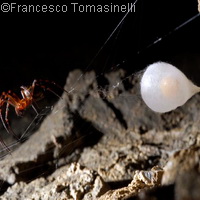Itsy bitsy spider with really long thread
Researchers have often reported on how spider silks are rich in strong mechanical properties, regardless of the species. However, the mechanical properties of stalks of silk taken from the egg sac of the cave spider Meta menardi have never before been analysed. Enter a team of researchers from Italy and the United States that put the European Society of Arachnology's 'European spider of the year 2012' in the spotlight. The study was recently published in the journal PLoS ONE. Scientists led by the Laboratory of Bio-Inspired Nanomechanics at the Politecnico di Torino in Italy collected silk stalks directly from a number of caves in Italy. Using the field-emission scanning electron microscope (FESEM), the team produced images showing that the stalks are made up of large threads, reaching lengths of up to 7.5 times more than their initial fibre length. European cave spiders generate silk in order to construct egg sacs that protect their developing young. Researchers also used a tensile testing machine that pulled on the silk fibres to gauge their breaking point. The majority of species secrete seven or eight types of silk for various purposes. For example, dragline silk anchors spiders to a surface, and other silks are used for web scaffolding to envelop prey. The female European cave spider generates tear-shaped egg sacs that hang from cave ceilings in dark and humid places. These sacs hang by short stalks made of tubuliform silk. The fibres are coated with a sticky substance that fastens them together. The data show that the densely and randomly packed fibres of the egg sac stalk can unroll to lengths that enable it to stretch significantly. 'The shapes of the stress-strain curves that we observed have a similar shape to that of carbon nanotube (CNT) bundles,' the authors write. 'These curves present a series of kinks or load drops which are an indication of sub-bundle failures when a bundle is pulled in a direction parallel to its axis. As we can see in our data, we also have a series of kinks indicating that the failure of the bundle, once it has reached its peak load, occurs with the fracture of sub-bundles. Though our curves were similar to those of CNT bundles, they were completely different to those of the dragline silk bundles and egg sac silk stalks. Comparing their results to ours, we see that their failure stresses and toughness are much higher. Surprisingly, the strains that our fibres sustained were impressively high: some stalks were pulled to more than 200%, reaching values of 721% to 751%, which have not been seen in any spider single thread or stalk of egg sac silk yet. Such enormous elongations suggest a huge unrolling mechanism in the stalk.' Professor Nicola Pugno from the Laboratory of Bio-Inspired Nanomechanics at the Politecnico di Torino received a European Research Council (ERC) Starting Grant of EUR 1 million under the EU's Seventh Framework Programme (FP7). The BIHSNAM ('Bio-inspired hierarchical super nanomaterials') project started earlier this year and supports research related to these results.For more information, please visit:PLoS ONE:http://www.plosone.org/home.actionPolitecnico di Torino:http://www.polito.it/
Countries
Italy, United States

